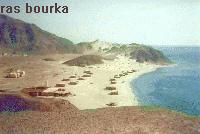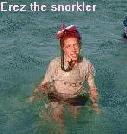
In the beginning of July 1996 Erez and I got back from our three day trip to the Egyptian Sinai peninsula. This was my first trip back to the Sinai in nearly twenty years, and my first time there since it was returned to Egypt. And for Erez it was a first trip out of Israel. And a great time it was!






We were three adults and seven children - three girls and four boys - all members of Erez's seventh grade class from Neve Ilan. We drove south in a moshav Ford transit - I was the driver as I have a license allowing me to drive a vehicle with ten passengers. We had plenty of camping gear - and the car was full.
Along the way south we made two short stops. The first was at Qumran - the site where the Dead Sea Scrolls were discovered in the forties. Here we viewed the remains of the Dead Sea sect who lived at the lowest place on earth two thousand years ago. And we saw, but did not enter, the cave in the side of the mountain where the scrolls were found.
A cave we did enter was the Flour Cave, just south of Mt. Sedom (site of the biblical city of Sedom). Here we took out flashlights, and made our way up a beautiful twisting canyon of clay, until we reached the entrance of the cave. There are many caves in the salt formation that forms the mountain of Mt. Sedom, but many of them are in danger of collapse. The Flour Cave is a relatively short, safe hike, with no crawling necessary. It gets very dark inside, but then one reaches the far side, and a climb back up to the Judean dessert.
After that, it was a drive straight south to the border. The total distance from Neve Ilan to the border is some 380 kilometers. We passed by Kibbutz Yahel, our former home. We reached Israel's southernmost city, Eilat, and parked the car in a lot just outside the Taba border crossing south of the city.
Everything we took, from sleeping bags, to food, a table, chairs, provisions for shade, etc., was loaded onto our backs and in our hands as we made our way for the biggest hike of the day - through the Israeli, and then Egyptian passport controls and checks. Everything went just fine (Erez received his passport in the mail two days before the journey). After we paid the exit tax on one side of the border, and the entrance tax on the other side of the border, we had our visas and we were in Egypt!
Okay, Taba and Sinai's Egypt coast are far away from Cairo and the pyramids, but we had a small taste of Egyptian mentality and attitudes when we met up with two drivers who were willing to take us, with all our gear, to our destination some forty kilometers further south. After getting in the cars, one of the drivers suddenly discovered that his car had no gas. We sat through a further thirty minutes as the Arabic speaking drivers tried to figure out what to do (apparently there was no gas station nearby), and tried to siphon gas from another car. Finally, they switched the gasless car, and we drove south.
There are two ways to spend a Sinai vacation. One is to stay on the move, hiking and seeing the sites, the various beaches, etc. The other way is just to stay put, and relax, and not move - and this was our vacation.
About forty kilometers south of Eilat is a huge sand dune called Ras Bukra. Unfortunately, this dune, once a great spot to run down a huge mountain of sand, is off limits, as shortly after the Egyptian-Israel peace treaty came into effect, an Egyptian soldier went insane and gunned down seven vacationing Israelis.
Near Ras Bukra is Basata, a very primitive, but nice holiday village run by a young man named Sherif, from Cairo. Sherif has a number of thatch huts along the shore, bathroom facilities and a public building where one can buy the all-important bottled water, and also get freshly baked (and scrumptious) rolls and thick-doughed pizzas. We didn't sleep in the huts - but pitched our shade, and sleeping bags on the beach itself. Along with Egyptian policy, the village was also drug and alchohol free, with no nude sunbathing, etc., all very different from when Israel was in control of the region.
Okay - what is so special about the beaches of Sinai? The eastern Sinai shoreline is known, world-wide, for its fabulous coral reefs and sealife. Our three days along the shore were spent snorkeling (which Erez picked up quickly) and viewing the reefs and the colorful fish, too beautiful to describe. Different times of day brought out more, or less fish. High tide brought the water to within a meter or two of where we slept, and low tide exposed the corals some fifty meters out so one could just wade in. There were times that the low waves splashed regularly along the beach, and there were times when the sea was still, a placid blue that faded into the distant shores of Saudi Arabia.
It was hot! While Israel was experiencing a very strong heat wave, the Sinai must have reached a good 50 degrees Centigrade (110 ? ). But it was a dry heat, and one quickly solved by dashing into the refreshing sea. We drank and drank, and one of the rules of our excursion was wearing a hat and a shirt at all times. And guess who got sunburnt? I fell asleep for about forty minutes in a spot of shade, with my feet exposed. So the inside of my feet , up to my knees, were burnt bright red. But the kids managed just fine. The sand was hot! We wore plastic thongs to go into the water as well.
It was a great experience, and we came back tired, but satisfied (the return journey north was uneventful - no hassle at the border or anything). I took plenty of pictures. One of the great things was that Erez and his classmates are really great kids, and still at an age when the only priority was having a good time, together.







